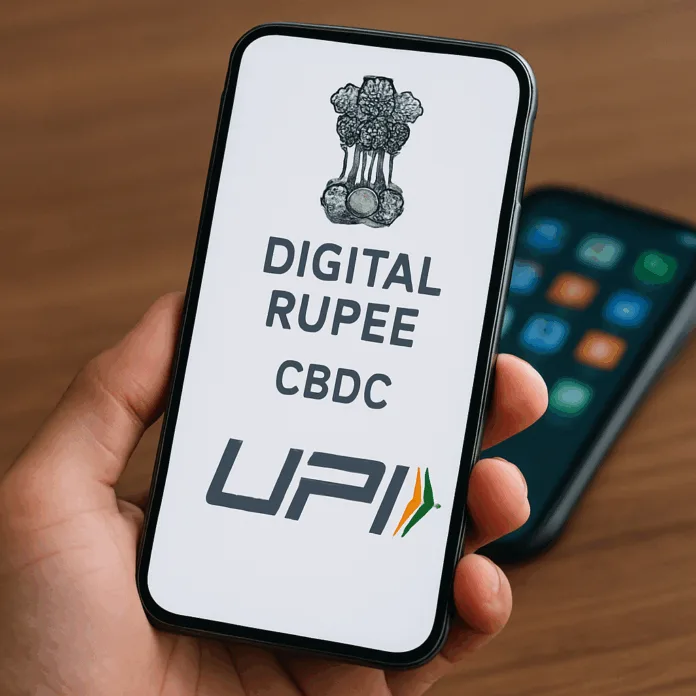
India’s financial ecosystem is undergoing a revolutionary shift with the Digital Rupee UPI integration, officially allowing users to transact using RBI’s e₹ through popular UPI apps like Paytm, PhonePe, and Google Pay. This strategic move by the Reserve Bank of India (RBI) marks a significant step toward adopting Central Bank Digital Currency (CBDC) in daily transactions and pushing India further into the age of fully digital banking.
The introduction of the Digital Rupee isn’t just a technological advancement—it represents a paradigm shift in how money is issued, stored, and circulated in a digital economy. With its seamless integration into the UPI (Unified Payments Interface) ecosystem, India is now among the few countries enabling large-scale public access to CBDC for real-time retail payments.
🔍 What is the Digital Rupee (e₹)?
The Digital Rupee, or e₹, is India’s official Central Bank Digital Currency issued by the RBI. Unlike cryptocurrencies such as Bitcoin or Ethereum, e₹ is a sovereign currency backed by the central bank, giving it the same legal status as physical cash.
Unlike regular bank money, the Digital Rupee is a direct liability of the Reserve Bank and is distributed through commercial banks. Now, with UPI integration, it can be used just like traditional digital payments—but with blockchain-based security and better traceability.
📱 How Digital Rupee Works with UPI Apps
With the Digital Rupee UPI integration, users can now:
Open an e₹ wallet directly within participating UPI apps.
Transfer funds peer-to-peer (P2P) or person-to-merchant (P2M) using QR codes.
Receive payments in e₹ and instantly use it across any UPI-enabled platform.
Monitor e₹ balances and transaction history in-app just like any bank wallet.
The process is designed to mimic existing UPI features, ensuring user familiarity and ease of adoption while maintaining the advantages of digital currency, such as faster settlements, reduced cash dependence, and blockchain transparency.
🧠 Why is Digital Rupee Important for India?
1. Modernizing India’s Digital Payments Infrastructure
India leads globally in digital transactions, and adding e₹ to the UPI ecosystem enhances the country’s fintech ecosystem further. It introduces state-backed digital money into an already thriving UPI network.
2. Secure and Transparent Transactions
Unlike cash, which is untraceable, digital rupee transactions are recorded securely using blockchain or distributed ledger technology. This helps in fraud prevention, improves accountability, and strengthens anti-money laundering systems.
3. Lower Transaction Costs
Since CBDC bypasses some interbank infrastructure, it reduces operational costs in the long run, especially for cross-border transactions and government subsidies.
4. Financial Inclusion
The seamless rollout through existing UPI apps ensures even remote and rural users with basic smartphone access can participate in the digital economy without the need for complex banking processes.
🏦 RBI’s Role and Pilot Program Success
The RBI first launched its Digital Rupee pilot program in late 2022 for wholesale banking and later expanded it to the retail sector. Over the years, the pilot showed strong adoption potential. With growing merchant onboarding and a rising number of wallet activations, 2025 marks a significant shift from pilot to public integration.
Now that Digital Rupee is integrated with UPI apps, RBI aims to reach millions of users and test real-time, scalable, interoperable systems for mass adoption.https://cricket-tips3.blogspot.com/2025/08/new-zealand-vs-zimbabwe-2025-match-preview-prediction.html
⚖️ Digital Rupee vs UPI and Wallets: What’s the Difference?
| Feature | Digital Rupee (e₹) | UPI Transfers | Digital Wallets |
|---|---|---|---|
| Issuer | RBI | Banks | Private companies |
| Backed By | Government of India | Banks | Wallet Balance |
| Interest Bearing | No | Yes (bank account) | No |
| Transaction Fees | Minimal | None | May vary |
| Offline Availability | Planned soon | Requires Internet | Some support offline |
| Blockchain-Enabled | Yes | No | No |
This shows how Digital Rupee complements, rather than replaces, existing systems.https://www.bhimupi.org.in/
🛍️ Where Can You Use the Digital Rupee?
Retail Stores: Many POS terminals are now e₹-enabled.
Online Shopping: Integration with e-commerce UPI gateways is rolling out.
Bill Payments: Recharge, utilities, and EMI payments using e₹ are now possible in supported apps.
Government Services: Future plans include direct transfer of subsidies or pensions via e₹.
🔮Benefits of Digital Rupee UPI Integration for Users
The digital rupee UPI integration is only the beginning. Future upgrades may include:
Offline Payments: Making e₹ usable without internet—great for rural India.
Cross-border CBDC Exchange: Allowing foreign remittances and global CBDC interconnection.
Programmable Money: Smart contracts may eventually allow conditional transactions like auto-tax deductions,digital rupee UPI integration .https://www.rbi.org.in/Scripts/FAQView.aspx?Id=155
As adoption grows, India is poised to become a global leader in CBDC innovation.
🧾 Final Thoughts
The integration of the Digital Rupee into UPI apps is a monumental leap in India’s fintech journey. It blends the trust of the Reserve Bank with the convenience of UPI, bringing the vision of a cashless, transparent, and inclusive economy closer to reality.
For users, it means one more payment option—but for the financial ecosystem, it signifies a foundational shift toward a digitally sovereign currency system.
related-topics